Measuring Border Delay and Crossing Times at the U.S.–Mexico Border—Part II
Step-by-Step Guidelines for Implementing a Radio Frequency Identification (RFID) System to Measure Border Crossing and Wait Times
APPENDIX C GSA FORM 1583 AND AMPLIFYING INFORMATION
GSA Form 1583
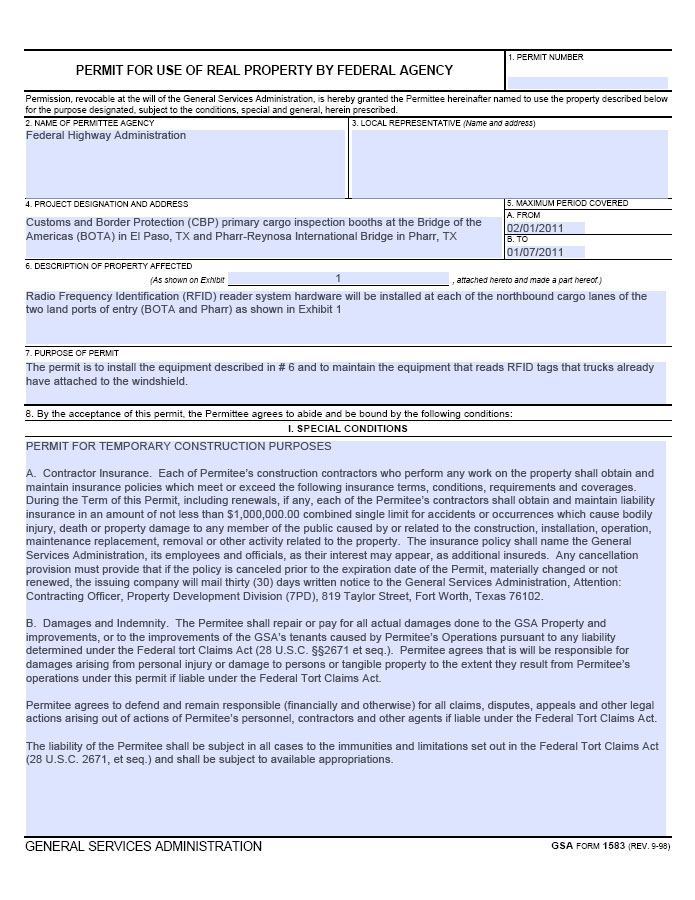
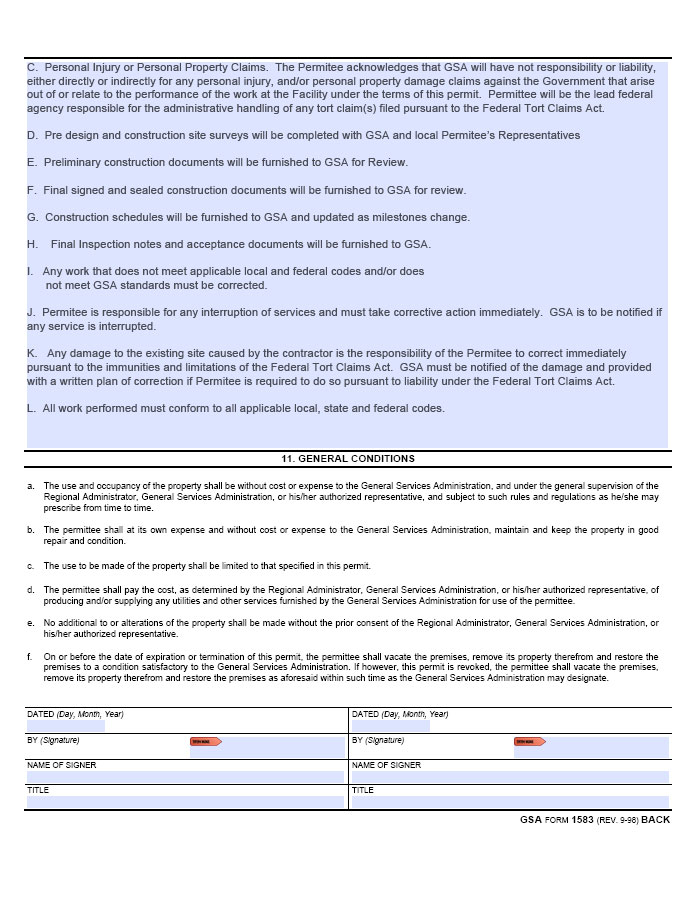
Amplifying Information for Submission of GSA Form 1583:
Permit for Use of Real Property by Use of Government Agency for RFID System Installation at CBP Primary Inspection Booths at the Bridge of the Americas and Pharr-Reynosa Ports of Entry
(Date)
1. Description of the Border Wait Time Measurement System and why it is important.
The proposed installation of automatic vehicle identification systems using radio frequency identification (RFID) tag reader equipment will enable automated measurement of wait time for northbound commercial vehicles, both at the Bridge of the Americas (BOTA) and Pharr-Reynosa land Ports of Entry (POEs) between Texas and Mexico. Wait time is defined as “the time it takes, in minutes, for a vehicle to reach the U.S. Customs & Border Protection (CBP) Primary Inspection booth after arriving at the end of the queue.” Wait time is a travel time component that is of particular importance to CBP as a metric of border flow. Knowing the accurate wait time helps CBP make informed decisions about how many Primary Inspection booths need to be manned.
USDOT and CBP collaboration resulted in an agreement to conduct a limited initial installation of readers at CBP Primary Inspection booths at the BOTA and Pharr-Reynosa POEs. Wait time implementation at both POEs will capitalize on equipment and capability that is already in place to automatically measure crossing time of northbound commercial vehicles. Crossing time is a travel time component that is of particular importance to FHWA as a metric of border flow. The general concept of the current RFID crossing time measurement system is that during its trip across the border at the POE, a northbound truck passes two RFID tag reader stations, one on each side of the border. Their antennae are mounted above lanes in the roadway. Each tag reader detects the truck’s RFID tag identification (ID) number and time-stamps and records its ID with the location of the detection. Tags of several types compatible with this system are carried in the vast majority of trucks crossing at BOTA and Pharr.
The initial RFID reader station is located at a site that is at the “upstream” end of the queue of northbound trucks that backs up from the border at the POE. The length of the queue at any given time will vary depending on factors such as truck volume, number of customs Primary Inspection booths manned and open, time of day, and incidents or accidents at the POE. The first RFID reader station is at a static location that is slightly upstream from the end of the historical queue that will develop on the majority of days on the Mexican side of the border. At the BOTA and Pharr POEs, that site is outside of a government compound. The second RFID reader station used for crossing time measurement is located at a site at or close to the point at which trucks exit from the gate of the final compound associated with commercial vehicle crossings. At the BOTA and Pharr POEs, that final compound is the Border Safety Inspection Facility (BSIF) that is operated by the Texas Department of Public Safety.
[NOTE: the Pharr border crossing currently has two more RFID reader stations than BOTA, developed in response to requests by the sponsor to provide more travel time detail. These additional readers were installed at locations to mark when a truck exits Mexico and just prior to arriving at the CBP Primary Inspection facility. Project sponsors want to capture the total wait time (including DPS inspection), thus the reader site requirement for the Pharr border crossing is for stations at the Mexico queue, CBP Primary Inspection, and the DPS exit. Consequently, one of the current Pharr RFID reader stations (at the end of the Rio Grande bridge on the U.S. side) may be relocated to fill a need at BOTA, since the reader to be installed at the downstream Pharr CBP Primary Inspection will give a more accurate wait time measurement.]
The proposed installation would segment the crossing at both POEs to allow measurement of wait time, by adding an additional reader station at the CBP Primary Inspection facility. The algorithm that currently measures crossing time between the current two reader stations (i.e., at the head of the queue and departing BSIF) at each of the subject POEs will be modified to also measure the commercial vehicle’s wait time (i.e., travel time from the head of the queue to reaching a Primary Inspection booth). The average wait time that is calculated will be shared with CBP. Without this scientifically measured information, wait times will only be anecdotal and thus imprecise.
2. Environment and conditions that must exist for the installation to be successful, and options – if any – that will enable accurate border wait time measurement other than installing on GSA property.
The equipment will be installed above the point where trucks depart the six Primary Inspection booths at each POE. Thus, the installation should take place either when the POE is closed to northbound commercial vehicle traffic or is experiencing low demand when lanes can remain closed. BOTA operates from 6:00 AM to 6:00 PM (Mountain Time) Monday through Friday and from 6:00 AM to 2:00 PM on Saturdays. BOTA is closed all day Sunday. The Pharr-Reynosa International Bridge Cargo Operations operates from 7:00 AM to 10:00 PM (Central Time) Monday through Friday and from 8:00 AM to 4:00 PM Saturdays and Sundays. The selected installation contractor has stated that he can conduct the installations on weekends. Since the Pharr POE is not closed Sundays, it is possible that certain lanes that are not open for the lower weekend traffic can be selectively instrumented.
In-depth analysis has been conducted by FHWA to determine the types of technology systems that are appropriate for automated travel time measurement at land border crossings. Only two types of current technology systems were considered viable and have been implemented for this purpose: AVI using RFID and GPS. RFID was considered best for measuring crossing times at Texas POEs, which resulted in the BOTA and Pharr implementations. The proposed RFID equipment installation to enable wait time capitalizes on existing RFID equipment and thus is the technology of choice both for BOTA and Pharr. Thus installation is required, and it must be located at the Primary Inspection booths to fulfill the goal of accurate wait time measurement. In fact, since the proposed system detects trucks as they leave the inspection booths, it is suggested that the wait time algorithm subtract the average time trucks spend in processing at the booths to have the most accurate average wait time.
3. Explanation of how the system will be operated and maintained and how any deficiency that occurs between installation and removal/completion will be addressed. Identification of any known threats or risk in this area that might happen, how they will be mitigated, and whether any safeguards are needed.
The RFID tag detection system is a self-contained independent system. The system will continually scan the area under the antenna and send any detected tag data to a Border Crossing Time central receiving application in El Paso, TX. There are no local users and no operators. The system uses open road tolling technology that is specifically manufactured for unmanned outdoor operation.
There is no programmed maintenance needed for the equipment (i.e., no devices that need scheduled local attention). In the event of system failure, maintenance will be coordinated with CBP by (performing organization). A representative of (performing organization) will travel to the location to perform repairs. Any activity planned onsite will be coordinated with GSA and CBP prior to staff arrival. Maintenance personnel will check with CBP upon arrival at the facility and provide a briefing on their task.
If the system were not working at all it would not affect the normal operation of the POE. The system in operation is innocuous. A compatibility test was run at the Pharr POE to determine whether there was interference with CBP systems, and there was no interference noted for the intended configuration. The nominal 915 MHz frequency of the RFID system can be remotely adjusted within narrow limits to improve performance. The system uses very little electricity. It will be programmed to turn off automatically at times when the POE is not in operation (primarily to save on wireless airtime costs). If the system is degraded or fails, there will be alert criteria that notify operators of the condition. Since the proposed system is not critical to port operations, a visit by a technician to repair or replace a failed component can simply be coordinated to occur during a time when the POE is not in operation.
There are no known threats or risks involving this technology system. RFID is a very familiar technology at the BOTA and Pharr POEs, and the sight of new reader stations should not arouse suspicion or animosity. For example, the BOTA RFID reader station at the head of the queue is located well back from the Mexican Export Lot. It includes pole, mast, solar power panel, battery platform and locked cabinets. It has not been subjected to any vandalism or other damage in the more than 18 months it has been in operation. Since the proposed system will be at the Primary Inspection booths, the risk of intentional damage is essentially nil.
4. Diagram with full description of all major components, operating frequencies, etc. with discussion of the appropriateness of the frequency for this use.
Major system components onsite include the following:
- RFID reader – Outdoor mounted unit containing all the electronics to interrogate passing windshield RFID tags and return tag data in a computer readable form. The RFID readers use the unlicensed ISM (Industrial, Scientific, and Medical) radio spectrum between 902MHz and 928MHz. The readers are compliant with the requirements of CFR Title 47, Part 15, which is part of the Federal Communications Commission rules and regulations that apply to unlicensed transmissions.
- RFID reader antenna – Rectangular panel type antenna (902-928MHz unlicensed ISM band) mounted over the booth travel lane and used to direct the radio signal from the reader onto the windshield area.
- Cellular wireless router – Receives tag data from the RFID reader as a serial stream and transmits these data to the central office application (El Paso) using a cellular wireless data connection.
Exhibit 1 shows the Primary Installation Diagram.
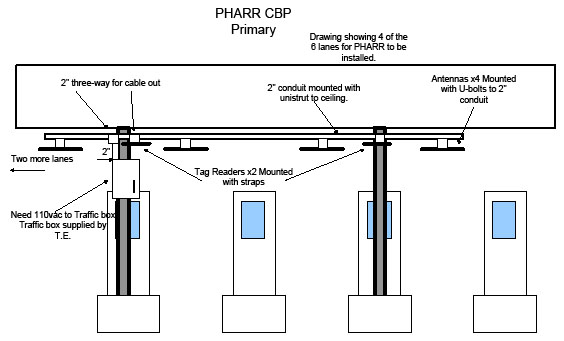
Exhibit 2 shows a visualization of the installation.
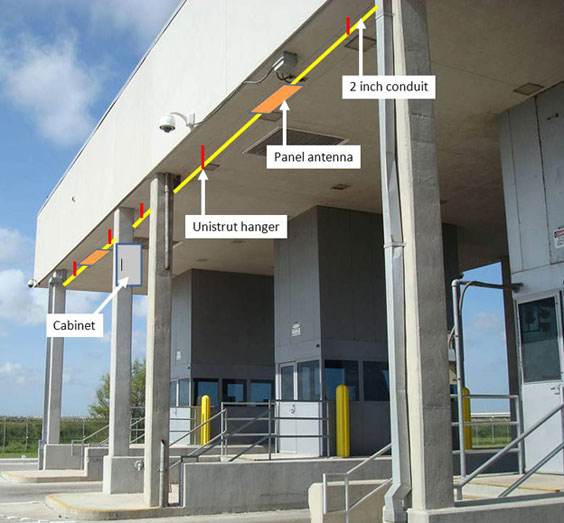
Exhibit 3 shows a representative electronics cabinet.
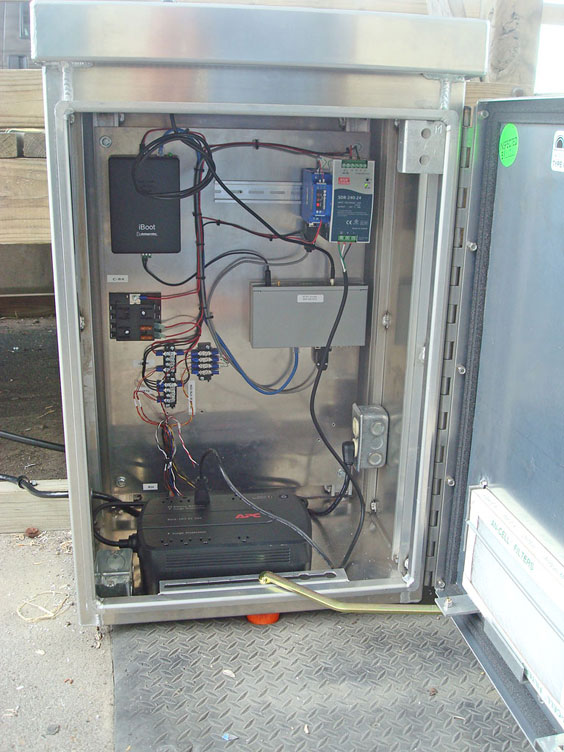
5. Contractor personnel who will be involved in the installation, their roles, and the frequency and nature of their activities during installation.
(Person’s and organization’s name removed) will be the lead installation technician and (person’s name removed) will be the (organization’s name removed) representative onsite during installation and test. (Person’s name removed) will oversee (person’s name removed) and insure that the installation is conducted as planned and presented to CBP.
Their contact information is:
- (Information removed: name, organization, phone number, e-mail address)
6. Constraints and Assumptions.
Constraints
- GSA and CBP approval of proposed installation and schedule (assume December).
- Equipment ordered and received (approximately two months lead time involved)
- Contractor availability for installation during a weekend or Mexican holiday when a POE is closed
- CBP authorization for the installation contractor and project personnel to be onsite
- Availability of standard 115V electrical power
Assumptions
- The subject installation has the support of CBP and USDOT for both BOTA and Pharr POEs
- CBP will have access to the wait time data measured at BOTA and Pharr, both real-time and archived data
- A plentiful supply of RFID tags compatible with the system to be installed is already carried by vehicles owned by Mexican carrier fleets that cross at the POEs
- Use of GSA facilities will be on a no-cost basis (i.e., no utility costs or rent).
- CBP personnel at BOTA and Pharr will provide all safety briefings necessary for team personnel while onsite at their respective facilities.
- Removal or continuation of equipment will be separately discussed at a scheduled point.
- CBP will notify project contacts if any known physical, operational, or perceptional problems with the equipment on its premises are discovered.
- Some type of separate data collection and measurement (i.e., manual collection or comparison with another technology) may be necessary to verify the results of the automated wait time measurement system.
7. Comprehensive schedule, including opportunity for GSA Program Managers to inspect and approve the installation configuration and a decision point for continued operation and maintenance.
Exhibit 4 is the Proposed Schedule.
| Activity | Nov-10 | Dec-10 | Jan-11 | Feb-11 | Mar-11 | Apr-11 | May-11 | Jun-11 | Jul-11 | Aug-11 | Sep-11 | Oct-11 | Nov-11 |
|---|---|---|---|---|---|---|---|---|---|---|---|---|---|
| Submit GSA Permit | |||||||||||||
| Obtain Authorization to Install Equipment | |||||||||||||
| Order Equipment | |||||||||||||
| Assemble and Test Equipment | |||||||||||||
| Installation at Pharr and BOTA* | |||||||||||||
| Test and Evaluation | |||||||||||||
| Border Crossing and Wait Time Reading | |||||||||||||
| GSA Inspect Installation Configuration | |||||||||||||
| FHWA & CBP decides continue operation or removal |
* Installation will be performed over the weekend and each site a week apart ↑
8. Points of contacts for all major activities described in the SOW.
- (Information removed: name, role, organization, phone number, e-mail address)